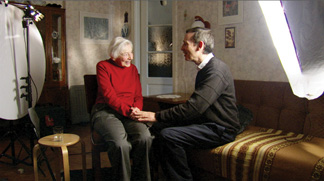
Mitchell Lieber has a complex story to tell.
It’s an uplifting story even while it is ghastly. It has strong connections to Kansas City’s Jewish community, to Lieber’s family here and in Latvia, and to the decimated Latvian Jewish community during the Holocaust.
Lieber, a Kansas City native who lives in Chicago, tells the story in his documentary film “Rumbula’s Echo,” which he wrote, directed and produced. In the film, he weaves together his family’s history with that of Nazi crimes against Jews in Latvia during World War II, culminating in the Rumbula Massacre near Riga, Latvia, on Nov. 30 and Dec. 8, 1941. Roughly 25,000 Jews were killed in the Rumbula forest or on the way to it. According to author Andrew Ezergailis in his book “The Holocaust in Latvia, 1941-1944: The Missing Center,” the Rumbula Massacre was largest mass murder of the Holocaust before the Nazi death camps, other than the Babi Yar massacre in Ukraine.
Lieber’s decision to make the documentary grew from his exploration of his family’s genealogy, he said. His resolve to learn his family’s history started at the naming ceremony for his newborn daughter in 1998. She was named after his great-grandmother, about whom he knew little.
Filming of “Rumbula’s Echo” started in 2009 in the Chicago area. More than 100 hours of footage have been shot, in six countries and languages. The main filming was completed by the end of 2010. Additional filming was done in 2012 to 2018 at more than 70 locations in six countries. A rough cut of excerpts that ran 77 minutes was finished in mid-2011 and shown in more than 15 locations in Latvia, Chicago, Germany and Israel.
“Many viewers thought it was a nearly finished film,” Lieber said. “However, at that point in the editing it was apparent to me that there were many missing pieces. I wanted to tell the more complete story and so pursued those pieces, some of them difficult ones.”
He is still in the process of editing the film’s rough cut, which is a “work in progress,” he said, and it now runs three hours. He plans in the next few months to schedule test screenings of the completed rough cut for this fall in various cities, possibly Kansas City included. Then Oregon Public Broadcasting will originate the film’s national broadcasting on PBS. The film is produced by the nonprofit Luminescence Media Group NFP. It was filmed by a crew with experience making documentaries for PBS, NBC, CBS and the BBC. The five leading historians of the film’s events were the film’s historical advisers.
The film has been supported by about 200 people and organizations across the country, including some Kansas City residents, the S&J Foundation, the Claims Conference, the International Holocaust Remembrance Alliance, the Foreign Office of Germany, the U.S. Department of State’s Latvia Embassy, the Illinois Humanities Council, the Jewish Federation of Chicago and the City of Chicago.
Lieber was born in Kansas City. From the late 1950s to the mid-1960s, until his family moved to Chicago, he attended Kehilath Israel Synagogue Religious School and services, and attended Beth Shalom Congregation with his late paternal grandfather, David Lieber, when he slept over at his grandparents’ house, he said. His late paternal grandmother was Rose Lieber. David Lieber was a cantor, Hebrew teacher and sofer (religious scribe) in Kansas City for about 50 years. He was the spiritual leader and cantor of a Kansas City congregation in the 1930s that later became Kehilath Israel. He started a Hebrew school that later merged with Beth Shalom, where he became the Torah reader.
David and Rose Lieber were born in what later became Latvia. He came to the United States in 1912, first to the East Coast and then to Chicago, where he owned a Jewish bookstore and tutored at the Hebrew Theological Seminary. She came to the U.S. in 1920, and they moved to Kansas City around 1927.
Many members of Lieber’s grandfather’s family were shot at Rumbula, he said. Several of Lieber’s family members who had Kansas City connections as natives or residents appear in the film, including his grandparents through archival family footage and photos; his parents, Herbert and Suzanne Lieber, who were members of Kehilath Israel; Lieber’s late aunt, Mirah Rostov (formerly Belzer, whose maiden name was Lieber); and Lieber himself.
When he started filming the documentary, “people came out of the woodwork” to take part, he said.
“Though I had researched the topic for several years, there was more to it than I expected,” he said. “During filming for a year, we learned that there were more people that were essential to interview and more archival images to research. Additionally, I found additional sources of archival interviews and footage to review and translate. The Holocaust scattered the survivors, footage and photographs, including pre-World War II images, worldwide. ‘Rumbula’s Echo’ located thousands of scattered pieces of this story in countries around the world and is putting selected ones together to tell the story. … It’s a big jigsaw puzzle, a thousand pieces culled from 80,000 pieces.”
Fundraising for the film has been more time-consuming that he had expected, which is always the case for independently produced documentaries, he said. But he sees that difficulty as insignificant compared to the reality the film depicts.
“Whenever this feels like an obstacle, I remind myself of the experiences of the documentary’s survivors and realize that we have an easy challenge, a walk in the park,” he said. “Also, bringing survivors’ stories to a wide audience is an important motivator.”
Filming interviews in six languages is complex because it requires using translators at each step in production and post-production, he said. During filming, a translator relays Lieber’s questions to the interviewees and then roughly translates their answers. During editing, translators create precise transcripts of the answers in English.
Lieber has made a couple of short films on related topics and took some film-making classes and a screenwriting course. His other job is as a consultant for call center systems.
The film is important for several reasons, he said, starting with its preservation of Holocaust history.
“Most important is that people will learn from it what we lost in the Holocaust and, by extension, what we lose in all genocide,” he said. “And people will learn about the mass murder methods of the Holocaust. Before there were death camps, there were mass shootings. Probably at least 20 percent of Holocaust victims were murdered by mass shootings.
“And then my goal as a filmmaker is really through the memory of the survivors and the words of witnesses — bystanders and perpetrators — so viewers have a better understanding of what this was like,” he said. “Most Jews in this country have not lived through it because of how many were murdered. It also shows that everybody has a compelling story waiting to be revealed in their family history.”
Follow the film’s progress by subscribing to its newsletter: Send email to and include your ZIP code, used for screening and broadcast notifications. Visit RumbulasEcho.org and facebook.com/RumbulasEchoFilm for more information.


